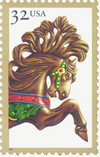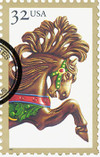
# 2979 - 1995 32c Carousel Horses: Brown Jumper
U.S. #2979
1995 Brown Jumper Carousel Horse
- This stamp is part of the American Folk Art Series
- It’s the second issuance of carousel animals
- Metallic gold ink borders each stamp
Stamp Category: Commemorative
Set: Carousel Horse
Value: 32¢
First Day of Issue: July 21, 1995
First Day City: Lahaska, PA
Quantity Issued: 3,125,000
Printed by: Ashton-Potter
Printing Method: Offset 160 subjects (10 across, 16 down)
Format: Panes of 20, vertical – 5 across and 4 down.
Perforations: 11.1
Why the stamp was issued: This stamp was issued due to the previous success of the 1988 carousel animals stamps issued as part of the American Folk Art Series.
About the stamp design: Paul Calle had designed the previous 1988 carousel animal stamps and was asked again to design the carousel horses. He used two carousel picture books as resources to his designs. The high mane horse was carved in the Country Fair Style around 1917.
Special design details: Ashton-Potter added microprinting into the design, but the Postal Service thought the phosphored paper and the metallic gold ink would discourage counterfeits. Also, poles to indicate carousel animals were left off the 1995 issues, while included in the 1988 issues because it was felt they were unnecessary.
About the printing process: Stamps were actually printed by a sub-contractor hired by Ashton-Potter. The company was Sterling Sommer located in Tonawanda, NY. They used an Akiyama 628 6-color sheetfed offset-press.
First Day City: The first-day ceremony was held at the Carousel World Museum in Lahaska, Pennsylvania, due to a suggestion made by Paul Calle. The golden lead horse, the black Indian horse, and the high-mane pony illustrated in #2976, #2977, and #2979 respectively, that Calle used as a reference, were present for the ceremony. Charlotte Dinger owner of the three horses brought them to the ceremony and left them on display for a few weeks.
History the stamp represents:
In 1892, the popularity of the carousel spread throughout the country as “Colonel” Charles Wallace Parker took a secondhand carousel across the Midwest, charging 5¢ per ride. Convinced he could build bigger and better portable carousels; he invested the profits in his own business.
As orders poured in for his carry-us-alls, Parker modified his horses to allow for easier stacking and transportation – prime considerations for portable carousels that had to be dismantled and rebuilt in record time. To achieve this, his horses assumed an exaggerated galloping stance, which also produced an illusion of reckless speed. Adorned with flags, rifles, and ears of corn, these horses often reflected a midwestern influence.
Pictured on the stamp, the Lillie Belle jumper with its dramatic, stylized mane, is one of Parker’s most admired carvings.
U.S. #2979
1995 Brown Jumper Carousel Horse
- This stamp is part of the American Folk Art Series
- It’s the second issuance of carousel animals
- Metallic gold ink borders each stamp
Stamp Category: Commemorative
Set: Carousel Horse
Value: 32¢
First Day of Issue: July 21, 1995
First Day City: Lahaska, PA
Quantity Issued: 3,125,000
Printed by: Ashton-Potter
Printing Method: Offset 160 subjects (10 across, 16 down)
Format: Panes of 20, vertical – 5 across and 4 down.
Perforations: 11.1
Why the stamp was issued: This stamp was issued due to the previous success of the 1988 carousel animals stamps issued as part of the American Folk Art Series.
About the stamp design: Paul Calle had designed the previous 1988 carousel animal stamps and was asked again to design the carousel horses. He used two carousel picture books as resources to his designs. The high mane horse was carved in the Country Fair Style around 1917.
Special design details: Ashton-Potter added microprinting into the design, but the Postal Service thought the phosphored paper and the metallic gold ink would discourage counterfeits. Also, poles to indicate carousel animals were left off the 1995 issues, while included in the 1988 issues because it was felt they were unnecessary.
About the printing process: Stamps were actually printed by a sub-contractor hired by Ashton-Potter. The company was Sterling Sommer located in Tonawanda, NY. They used an Akiyama 628 6-color sheetfed offset-press.
First Day City: The first-day ceremony was held at the Carousel World Museum in Lahaska, Pennsylvania, due to a suggestion made by Paul Calle. The golden lead horse, the black Indian horse, and the high-mane pony illustrated in #2976, #2977, and #2979 respectively, that Calle used as a reference, were present for the ceremony. Charlotte Dinger owner of the three horses brought them to the ceremony and left them on display for a few weeks.
History the stamp represents:
In 1892, the popularity of the carousel spread throughout the country as “Colonel” Charles Wallace Parker took a secondhand carousel across the Midwest, charging 5¢ per ride. Convinced he could build bigger and better portable carousels; he invested the profits in his own business.
As orders poured in for his carry-us-alls, Parker modified his horses to allow for easier stacking and transportation – prime considerations for portable carousels that had to be dismantled and rebuilt in record time. To achieve this, his horses assumed an exaggerated galloping stance, which also produced an illusion of reckless speed. Adorned with flags, rifles, and ears of corn, these horses often reflected a midwestern influence.
Pictured on the stamp, the Lillie Belle jumper with its dramatic, stylized mane, is one of Parker’s most admired carvings.












